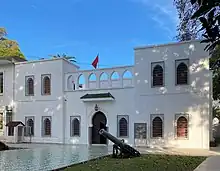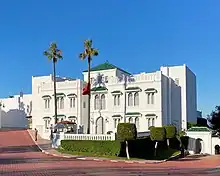

The Mendoub or Mandub (Arabic: مندوب, "delegate" or "representative") was a key official in the governance of the Tangier International Zone between 1925 and 1956, with a wartime interruption from 1940 to 1945.
Overview
The Mendoub represented the symbolic authority of the Sultan of Morocco in the International Zone, even though its government was led by the separate Comité de Contrôle that brought together the main foreign powers. He was directly in charge of the affairs of the Muslim and Jewish communities which together formed the vast majority of Tangier's inhabitants. He also chaired the Zone's parliamentary assembly, a largely symbolic role since he did not have a vote.[1]: 310 His autonomy was limited by close oversight by a French official, the Contrôleur des Autorités Chérifiennes,[1]: 310 operating under the powerful Direction des Affaires Indigènes in Rabat.[1]: 311
Muhammad ben Abdelkrim at-Tazi Bu Ashran was the first Mendoub, from the office's creation to his death in 1954, staying in Rabat while the Zone fell under Spanish occupation during World War II.[2]: 275 He had previously been the Naib or Sultan's representative to the foreign communities in Tangier, from 1913 to 1925. He was succeeded in 1954 by his son Ahmad at-Tazi, who held the role briefly until its termination in 1956.
Properties
The Mendoub's ceremonial office was installed in the former German consulate building, which had been confiscated following World War I and used by the Naib from January 1920.[3] This property was subsequently known as the Mendoubia.
From 1929 the Mendoub resided in a palatial residence in the waterfront neighborhood of Marshan, from which he proceeded to the Mendoubia in a colorful ceremonial that became a tourist attraction.
Also in the 1920s, a suburban property was built for the Mendoub in the hills above Rmilat to the west of Tangier; this later fell into disrepair before being eventually purchased by Katara Hospitality. It was subsequently renovated on a design by OBMI/CCCRA Architects and integrated in a hotel development opened in November 2022 as Fairmont Tazi Palace Tangier.[4]
See also
References
- 1 2 3 Francesco Tamburini (2005), "L'amministrazione della giustizia nella zone internazionale di Tangeri (1923-1957)", Africa: Rivista trimestrale di studi e documentazione dell'Istituto italiano per l'Africa e l'Oriente, 60:3/4 (3/4): 305–339, JSTOR 40761805
- ↑ Silvia Nélida Bossio, ed. (2011), Aproximación a los edificios históricos y patrimoniales de Málaga, Tetuán, Nador, Tánger y Alhucemas / Un Rapprochement entre les édifices historiques et patrimoniaux de Malaga, Tétouan, Nador, Tanger et Al Hoceima (PDF), Servicio de Programas del Ayuntamiento de Málaga
- ↑ "L'exécution du traité de paix au Maroc". L'Illustration. January 1920.
- ↑ Anne-Claire Delorme (20 January 2023). "On a poussé les portes du Fairmont Tazi Palace Tangier, palais perché dans le ciel de Tanger". Le Figaro.